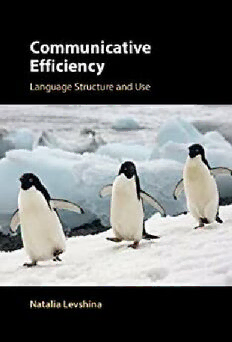
Communicative Efficiency: Language Structure and Use PDF
Preview Communicative Efficiency: Language Structure and Use
Communicative Efficiency All living beings try to save effort, and humans are no exception. This groundbreakingbookshowshowwesavetimeandenergyduringcommuni- cation by unconsciously making efficient choices in grammar, lexicon and phonology.Itpresentsanewtheoryof‘communicativeefficiency’,theidea that language is designed to be as efficient as possible, as a system of communication.Thenewframeworkaccountsforthediversemanifestations ofcommunicativeefficiencyacrossatypologicallybroadrangeoflanguages, using various corpus-based and statistical approaches to explain speakers’ bias towards efficiency. The author’s unique interdisciplinary expertise allowshertoproviderichevidencefromabroadrangeoflanguagesciences. Sheintegratesdiverseinsightsfromoverahundredyearsofresearchintothis comprehensible new theory, which she presents step-by-step in clear and accessiblelanguage.Itisessentialreadingforlanguagescientists,cognitive scientistsandanyoneinterestedinlanguageuseandcommunication. natalia levshina is a postdoctoral researcher at the Neurobiology of Language Department, Max Planck Institute for Psycholinguistics. She is theauthorofthebest-sellingbookHowtoDoLinguisticswithR(2015). Published online by Cambridge University Press Published online by Cambridge University Press fi Communicative Ef ciency Language Structure and Use Natalia Levshina MaxPlanckInstituteforPsycholinguistics,TheNetherlands Published online by Cambridge University Press ShaftesburyRoad,CambridgeCB28EA,UnitedKingdom OneLibertyPlaza,20thFloor,NewYork,NY10006,USA 477WilliamstownRoad,PortMelbourne,VIC3207,Australia 314–321,3rdFloor,Plot3,SplendorForum,JasolaDistrictCentre, NewDelhi–110025,India 103PenangRoad,#05–06/07,VisioncrestCommercial,Singapore238467 CambridgeUniversityPressispartofCambridgeUniversityPress&Assessment, adepartmentoftheUniversityofCambridge. WesharetheUniversity’smissiontocontributetosocietythroughthepursuitof education,learningandresearchatthehighestinternationallevelsofexcellence. www.cambridge.org Informationonthistitle:www.cambridge.org/9781108840798 DOI:10.1017/9781108887809 ©NataliaLevshina2023 Thispublicationisincopyright.Subjecttostatutoryexceptionandtotheprovisions ofrelevantcollectivelicensingagreements,noreproductionofanypartmaytake placewithoutthewrittenpermissionofCambridgeUniversityPress&Assessment. Firstpublished2023 AcataloguerecordforthispublicationisavailablefromtheBritishLibrary. ISBN978-1-108-84079-8Hardback CambridgeUniversityPress&Assessmenthasnoresponsibilityforthepersistence oraccuracyofURLsforexternalorthird-partyinternetwebsitesreferredtointhis publicationanddoesnotguaranteethatanycontentonsuchwebsitesis,orwill remain,accurateorappropriate. Published online by Cambridge University Press To my teachers Published online by Cambridge University Press Published online by Cambridge University Press Contents List of Figures page x List of Tables xii Preface xv Acknowledgements xvi List of Abbreviations xvii Part I Different Types of Efficiency inLanguage 1 1 Communicative Efficiency: Main Concepts 3 1.1 WhatIsCommunicativeEfficiency? 3 1.2 BenefitsandCostsinCommunication 8 1.3 HowtoBeEfficient? 18 1.4 ThreePrinciplesofEfficientCommunication 23 1.5 ‘Good-Enough’Efficiency 29 1.6 Conclusions 34 2 Efficiency and FormalLength 36 2.1 EfficientLengthAsymmetries 36 2.2 AccessibilityofReferentsandLengthofReferentialExpressions andMarkers 37 2.3 GrammaticalCodingAsymmetriesandSplits 46 2.4 TheUseandOmissionofClauseConnectors 50 2.5 Same-SubjectandDifferent-SubjectConstructions 55 2.6 Zipf’sLawofAbbreviation 57 2.7 PhoneticReductionandEnhancement 61 2.8 Conclusions 65 3 Efficiency and theOrderof Meaningful Elements 66 3.1 EfficientOrder 66 3.2 FactorsDeterminingEfficiencyofOrder 66 3.3 Cross-LinguisticManifestationsofEfficientOrder 76 3.4 StarWarsandViolationsofConventionalWordOrder 90 3.5 Conclusions 93 vii Published online by Cambridge University Press viii Contents 4 OtherWays of Saving Effort 95 4.1 EfficiencyBeyondCodingLengthandWordOrder 95 4.2 PreferenceforAccessibleUnitsandInterpretations 95 4.3 AnalyticSupport 97 4.4 HorrorAequi,orAvoidanceofIdentity 100 4.5 EntryPlaceforNewReferents 102 4.6 Conclusions 103 PartII Efficiency and Language Evolution 105 5 Emergence of Efficient Language Patterns 107 5.1 ChangesLeadingtoEfficientPatterns 107 5.2 Efficiency-DrivenFormalReduction 109 5.3 Efficiency-DrivenFormalEnhancement 111 5.4 CausalModelsofFormalReductionandEnhancement 118 5.5 Suppletion,CompositionalityandtheCompetitionofMeaningsforForms 128 5.6 WordOrderOptimization 130 5.7 ANoteonTeleology 132 5.8 Conclusions 134 6 From Trade-Offs toCausal Networks 136 6.1 Trade-OffsinLinguistics 136 6.2 ProblemswithTrade-Offs 139 6.3 FromtheTrade-OffbetweenCaseMarkingandWordOrdertoaMultivariate CausalNetwork 144 6.4 Conclusions 151 PartIII Case Studies 153 7 Efficient Form–MeaningMapping inCausative Constructions 155 7.1 TheCausativeContinuum 155 7.2 MoreThanJustDirectandIndirectCausation 161 7.3 CompetitionbetweenFormalParameters 175 7.4 DiachronicEvidence 182 7.5 AnArtificialLanguageLearningExperiment 187 7.6 Conclusions 191 8 DifferentialCase Markingand Efficiency 193 8.1 DifferentialCaseMarking 193 8.2 Cross-LinguisticGeneralizationsRelatedtoDifferentialCaseMarking 195 8.3 ExplanationsofDifferentialCaseMarking 203 8.4 ReverseEngineering:Cross-LinguisticGeneralizationsandCorpusData 208 8.5 DevelopmentofDifferentialCaseMarking 223 8.6 ExperimentalEvidencefromArtificialLanguages 226 8.7 Conclusions 228 9 Efficient Use of Function Words inEnglish Alternations 230 9.1 Construction–FillerPredictabilityandEfficiency 230 9.2 Stay(at)Home,SaveLives! 232 Published online by Cambridge University Press Contents ix 9.3 EfficientUseofHelp(to)Infinitive 234 9.4 AlternationGo(and)Verb 240 9.5 Conclusions 244 10 Conclusions andPerspectives 245 Appendices 250 Appendix1 List ofLanguages in theTypological Sample Used in Chapter 7 251 Appendix2 CorpusFrequencies ofDifferent Aand P from Previous StudiesUsed inChapter 8 253 References 256 Index 288 Published online by Cambridge University Press
